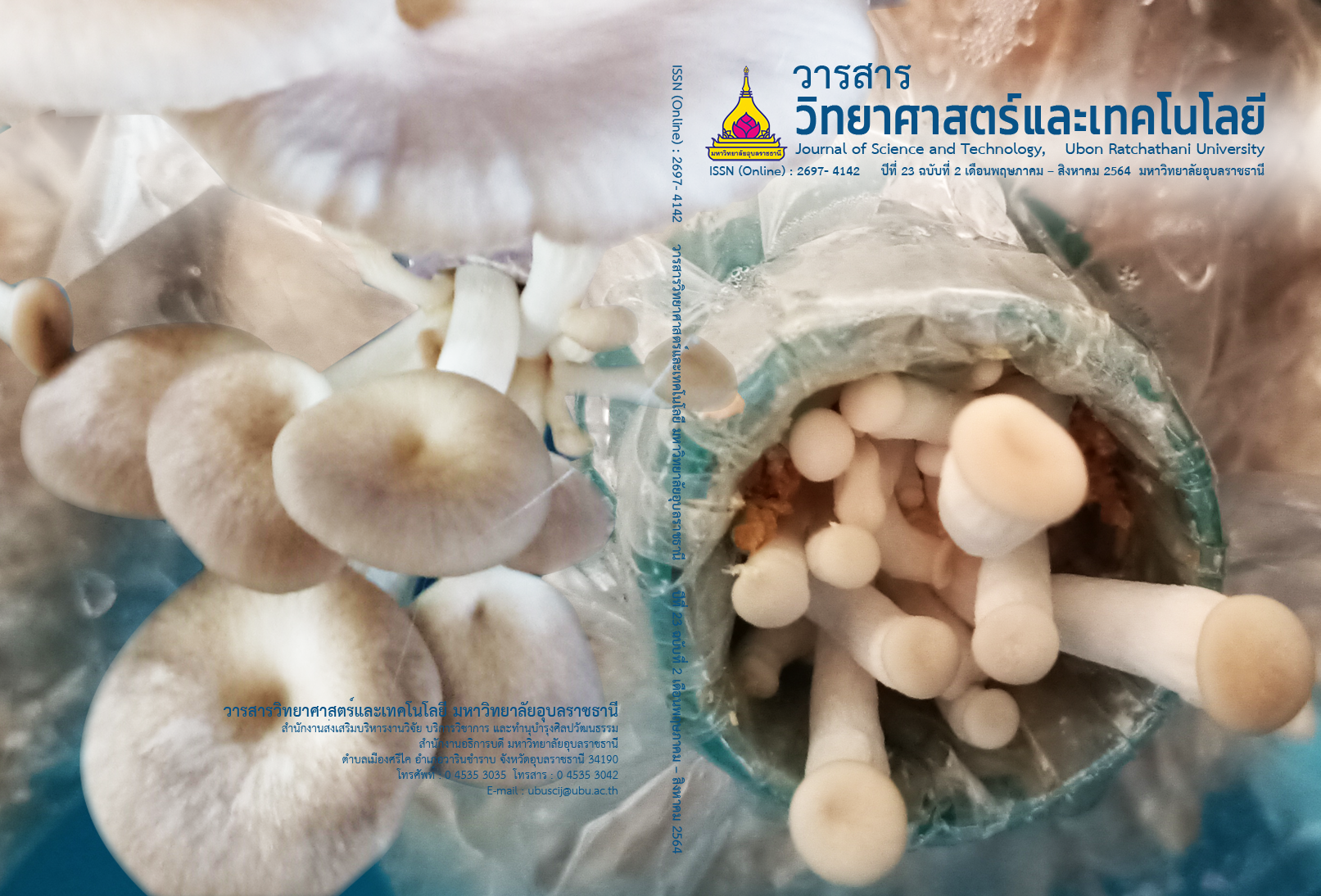การเปรียบเทียบสารสกัดจากวัชพืชวงศ์ Asteraceae ในการเป็นสารฆ่าและสารยับยั้งการเจริญเติบโตของหนอนกระทู้ผัก
Main Article Content
บทคัดย่อ
วัตถุประสงค์ของการศึกษาเพื่อเปรียบเทียบสารสกัดจากวัชพืชวงศ์ Asteraceae (สาบเสือ, Chromolaena odorata (L.) R.M. King & H. Rob) สาบแร้งสาบกา, Ageratum conyzoides L. และสาบม่วง, Praxelis clematidea) ในการเป็นสารฆ่าและสารยับยั้งการเจริญเติบโตของหนอนกระทู้ผัก (Spodoptera litura) วัย 4 โดยวิธีการจุ่มใบคะน้า (leaf dipping method) ที่ระดับความเข้มข้น 0, 0.5, 1.0, 2.0, 4.0 และ 8.0% (w/v) นำใบคะน้าใส่กล่องเลี้ยงแมลงปล่อยหนอนกระทู้ผัก, Spodoptera litura (Fabricius) วัย 4 ที่อดอาหาร 12 ชั่วโมง จำนวน 10 ตัวต่อกล่อง ทดสอบ 5 ซ้ำ พบว่าสารสกัดสาบเสือมีผลในการเป็นสารฆ่าและสารยับยั้งการเจริญเติบโตของหนอนกระทู้ผักวัย 4 สูงสุดมีความแตกต่างกันอย่างมีนัยสำคัญที่ความเชื่อมั่น 95% ที่ความเข้มข้นที่ 8% ของสาบเสือมีผลในการเป็นสารฆ่าหนอนกระทู้ผักวัย 4 มีเปอร์เซ็นต์การตายสูงสุดอยู่ที่ 100% ที่เวลา 24 ชั่วโมง และค่า LC50 เท่ากับ 1.41 ในการเป็นสารยับยั้งการเจริญเติบโตที่ความเข้มข้น 0.5% ของสาบเสือระยะดักแด้มีเปอร์เซ็นต์การตาย 42.0% ระยะเวลาของตัวเต็มวัยใช้เวลาเฉลี่ย 8.20 + 0.74 วัน ในขณะที่สารสกัดวัชพืชสาบแร้งสาบกาและสาบม่วงระยะดักแด้มีเปอร์เซ็นต์การตายเท่ากับ 18.0 และ 20.0% ตามลำดับ ระยะเวลาของตัวเต็มวัยใช้เวลาเฉลี่ย 5.80 + 0.97 และ 6.00 + 0.63 วัน ตามลำดับ เมื่อเปรียบเทียบกับชุดควบคุมไม่มีเปอร์เซ็นต์การตาย ดังนั้นสารสกัดจากสาบเสือสามารถนำมาฉีดพ่นในแปลงเกษตรกรและปลอดภัยต่อสุขภาพมนุษย์และสิ่งแวดล้อม
Article Details
บทความที่ได้รับการตีพิมพ์เป็นลิขสิทธิ์ของ วารสารวิทยาศาสตร์และเทคโนโลยี มหาวิทยาลัยอุบลราชธานี
ข้อความที่ปรากฏในบทความแต่ละเรื่องในวารสารวิชาการเล่มนี้เป็นความคิดเห็นส่วนตัวของผู้เขียนแต่ละท่านไม่เกี่ยวข้องกับมหาวิทยาลัยอุบลราชธานี และคณาจารย์ท่านอื่นๆในมหาวิทยาลัยฯ แต่อย่างใด ความรับผิดชอบองค์ประกอบทั้งหมดของบทความแต่ละเรื่องเป็นของผู้เขียนแต่ละท่าน หากมีความผิดพลาดใดๆ ผู้เขียนแต่ละท่านจะรับผิดชอบบทความของตนเองแต่ผู้เดียว
เอกสารอ้างอิง
Thai-PAN: Pesticide residue in fruit
and vegetable over standard 41%.
Matichon online. 2019 June 26. (in
Thai)
[2] Ek-Amnuay, P. 2010. Diseases and
pests of economic importance (3rd
ed). Bangkok: Amarin Printing &
Publishing Public Company Limited. (in
Thai)
[3] Siriphontangmun, S. and et al. 2011.
Insect pests of vegetable mushroom
and cut flower (1st ed). Bangkok: The
Agricultural Cooperative Federation of
Thailand. Limited. (in Thai)
[4] Tong, H., Su, Q. and Zhou, X. 2013.
Field resistance of Spodoptera
litura (Lepidoptera: Noctuidae) to
organophosphates, pyrethroids,
carbamates and four newer chemistry
insecticides in Hunan, China. Journal
of Pest Science. 86(3): 599-609.
[5] Ahmad, M. and Mehmood, R. 2015.
Monitoring of resistance to new
chemistry insecticides in Spodoptera
litura (Lepidoptera: Noctuidae) in
Pakistan. Journal of Economic
Entomology. 108(3): 1279–1288.
[6] Isman, M.B. 2020. Botanical insecticides
in the Twenty-First Century-Fulfilling
their promise?. Annual
Review of Entomology. 65: 233-249.
[7] Gibson, M. 2010. Weeds: a brief
introduction. Victorian Naturalist.
127(4): 96-103.
[8] Abbott, W.S. 1925. A method for
computing the effectiveness of an
insecticide. Journal of Economic
Entomology. 18: 265–267.
[9] Finney, D.J. 1971. Probit Analysis, 3rd ed.
Cambridge University Press, London.
[10] Udebuani, A.C. and et al. 2015.
Studies on the insecticidal properties
of Chromolaena odorata (Asteraceae)
against adult stage of Periplaneta
Americana. Journal of Entomology
and Zoology Studies. 3(1): 318-321.
[11] Shu, B. and et al. 2018. Azadirachtin
affects the growth of Spodoptera
litura Fabricius by inducing apoptosis
in larval midgut. Frontiers
in Physiology. 9: 1-12.
[12] Ali, S. and et al. 2018. Toxicity of
Nerium odorum (A.) & Parthenium
Hysterophorus (L.) botanicals against
Spodoptera litura (L.). Pakistan
Entomologist. 40(1): 51-55.
[13] Nambiar, G.J. and et al. 2017.
Bioefficacy of leaf extracts of
Clerodendrum infortunatum L. and
Eupatorium odoratum L. on both
quantitative and qualitative analysis of
midgut protein of sixth instar larvae of
Orthaga exvinacea Hampson
(Lepidoptera: Pyralidae). International
Journal of Biosciences. 6(1): 19-25.
[14] Chinnamani, T., Sivakami, R. and
Jeyasankar, A. 2016. Antifeedant,
larvicidal and growth regulatory
activities of fractions isolated from
ethyl acetate extract of
Pseudocalymma alliaceum against
Spodoptera litura Fabricius and
Helicoverpa armigera Hübner
(Lepidotera: Noctuidae). International
Journal of Advanced
Research in Biological Sciences. 3(9):
98-107.
[15] Ray, D.P. and et al. 2012. Insect
growth regulatory activity of Thevetia
nerifolia Juss. against Spodoptera
litura (Fab.).
Journal of Applied Botany
and Food Quality. 85: 212–215.
[16] Renuga, F.B. 2013. Growth Inhibitory
Activities of Ageratum conyzoides Linn
and Artemesia vulgaris Linn of
Asteraceae 15 against Spodoptera
litura Fab (Lepidoptera: Noctuidae).
International Journal of Botany and
Research. 3(4): 13-20.


